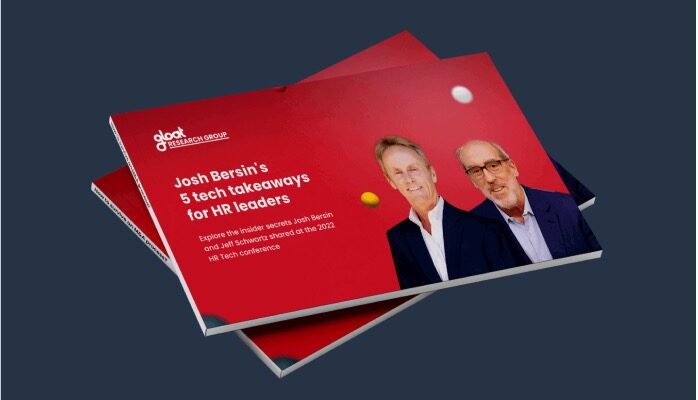5 talent management priorities for HR leaders
Learn what initiatives sit at the top of the HR world’s agenda

Now that we’ve entered the Post-Industrial Age, the same old talent management strategies will no longer cut it. Instead of making small tweaks, leaders must embrace new frameworks and next-generation tools that unlock agility and empower employees to achieve their full potential.
While most executives recognize that it’s time to make bold changes, there’s still a lot of uncertainty about what actions they should take first. Although every business’s agenda will differ, there are a few talent management goals that all HR leaders should keep top of mind to set their organizations up for success in the Post-Industrial Age.
6 talent management best practices
If you’re looking to level up your talent management strategy, here are a few tips to get started:
#1. Harness AI-powered tools for strategic workforce planning
A new generation of AI-powered tools has the potential to transform strategic workforce planning processes. Rather than struggling to determine which capabilities your workforce will need to build in the future, skills intelligence tools like Gloat’s Skills Foundation present leaders with a bird’s eye view of the competencies their people have and identify emerging knowledge gaps before they snowball into bigger problems.
#2. Cultivate a compelling culture
As the competition for in-demand skills intensifies, leaders must ensure they’re going the extra mile to retain talent with these sought-after competencies. To create an environment that brings out everyone’s best, connect employees to career development opportunities that align with their long-term professional ambitions. Many companies are harnessing talent marketplaces to generate suggestions for projects, gigs, and mentorships that will help people build the skills needed to level up their careers.
#3. Prioritize experiential learning
When it comes to skill-building, not all approaches are created equal. Instead of relying solely on L&D content, give people the chance to put the lessons they’re learning into practice through hands-on learning opportunities such as mentorships and shadowing.
#4. Take an internal-first approach to talent acquisition
Traditionally, employers brought new talent into their organization whenever they had a vacancy to fill. But in our new world of work, it’s often in companies’ best interest to reskill and upskill internal talent before looking to the outside market. It is 1.7 times more expensive to recruit, train, and onboard talent from outside your organization and these new hires are 61% more likely to be terminated when compared to existing members of your organization.
#5. Say goodbye to silos
While rigid job hierarchies may have performed well in a working world that was stable and predictable, they won’t hold up in the ever-evolving Post-Industrial chapter we’re entering. Instead, employees should be encouraged to put their skills to use across the organization through dynamic talent reallocations that align people to high-priority opportunities based on their capabilities and capacity.
#6. Develop upskilling and reskilling for the AI age
Now that AI is going mainstream, leaders must create pathways to empower employees to build the capabilities they’ll need to harness these systems effectively. Although two-thirds of executives say that they won’t hire someone without AI skills, only 25% of companies plan to offer AI training this year. Set your business apart by becoming one of the top-performing organizations that is committed to equipping their workforce with the expertise needed to use AI to augment and automate their workflows.
5 talent management goals that HR leaders should prioritize
From promoting meaningful diversity and inclusion initiatives in the workforce to empowering employees to hone new skills, HR’s agenda is filled with opportunities to drive change and generate tangible results for both their people and their organizations. Here are the top five areas of focus that we think HR and talent management leaders should address, based on Gartner’s research on HR priorities and insights from Deloitte.
#1. The shift to becoming a skills-based organization
Building a skills-based talent framework is emerging as the most successful strategy for unlocking organizational agility and preparing your business for our fast-paced and ever-evolving world of work.
Shifting to a skills-based approach has the potential to not only enhance efficiency but also to connect employees to tasks that align with their ambitions and expertise. Research from Forbes shows people who work at a skills-based organization are 79% more likely to have a positive work experience, which is part of the reason why 98% of organizations want to give this approach a try. 90% of companies are already beginning to experiment with skills-based strategies.
While many leaders are prioritizing skills, getting employees on board may be a challenge of its own since workers are becoming more resistant to organizational change. Only about 50% of employees currently trust their organizations.
Consequently, HR leaders can’t solely prioritize designing skills-based strategies; they must also determine what it will take to turn these visions into realities. Skills intelligence tools will become a necessity for powering skills-based organizations, as these systems give leaders a clear picture of the capabilities their organization has and the expertise that should be prioritized next.
#2. Maximizing leader and manager effectiveness
As organizations and societies evolve, so do expectations for what leaders and managers are capable of, making these roles more complex. 76% of HR leaders acknowledge that their managers are overwhelmed by the growth of their job responsibilities and 73% aren’t equipped to lead change.
To help managers thrive in today’s work environment, leaders must be authentic, empathetic, and adaptive. While HR strives to help leaders build the confidence needed to answer the call, human-centered leadership remains the exception rather than the rule.
HR leaders have an opportunity to help management deliver on the need for human-centered leadership by architecting ways of working that prioritize autonomy and flexibility. This includes putting employees at the helm of their career progression by equipping them with tools that spotlight development opportunities across the organization, like a talent marketplace.
#3. Reimagining the employee experience
Employee experience is now a top priority for almost 1 out of every 2 HR leaders. Many executives recognize that a compelling workplace experience is linked with an array of game-changing benefits, including less turnover, enhanced productivity, and better profits.
While most leaders are eager to launch initiatives that will move the needle on employee experience, many are struggling to identify the changes that will generate the most impact. Career development is emerging as a crucial area of focus, given that 86% of HR leaders believe career paths at their organizations are unclear for many employees.
Since 2 out of 3 workers acknowledge that they would leave their jobs if internal mobility wasn’t offered, HR leaders are prioritizing meaningful career development as a means to retain and engage their workforce. To take employee experience to new heights, pioneering companies are harnessing talent marketplaces to create a culture of engagement by matching people to opportunities that align with their interests and goals.
#4. Embracing new recruiting strategies
Many organizations are already grappling with talent shortages—and these conditions are about to get more severe. 50% of organizations expect the competition for talent to increase significantly in the next six months, regardless of broader macroeconomic conditions.
Consequently, talent acquisition teams will need to rethink their go-to strategies for sourcing talent. Rather than relying primarily on external hiring, organizations are increasingly looking inward and tapping into the skills their existing employees have to minimize hiring costs while upping efficiency. Leaders who harness skills intelligence tools will gain a full picture of their organization’s capabilities, equipping them with the insights they need to make smart decisions about what skills they want to build (through upskilling efforts), borrow (through an internal marketplace), and buy (through external hiring).
#5. Preparing for future challenges
Amid today’s accelerated pace of change and ongoing disruptions, no executive wants to be caught off guard. In fact, 42% of HR leaders view preparing for the future of work as a top priority.
Workforce planning—the ability to anticipate future talent needs—sits at the heart of a winning future of work strategy. To prepare for the future of work, workforce planning must encompass all of the dynamic factors that leaders are currently grappling with, including shifting skills needs, talent scarcities, high turnover rates, and changes in the employee-employer dynamic. However, the majority of HR leaders acknowledge that their organization’s workforce planning is currently limited to headcount planning.
Rather than sticking with rudimentary approaches to prepare for the future of work, leaders must harness next-generation tools that put skills and business needs in context. As a central platform designed to help executives understand their workforce, inform talent strategy, and drive business growth, skills intelligence tools are becoming the backbone for impactful workforce planning.
Want to learn some more talent management tips from the one-and-only Josh Bersin? Check out our guide to learn his five HR tech takeaways for HR leaders.





